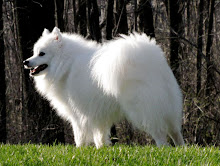October 24, 2009
According to Heidi Booth, DVM, dogs age differently, depending on their size, breed, health and genetic predisposition. In an interview with DogWorld magazine, Booth states, "In general, we consider dogs to be seniors around the age of 7; however, this does vary. Typically, smaller dogs (less than 20 pounds) live longer, not showing their age until 10 to 12 years. Medium-sized dogs (20 - 55 pounds) begin to age at 8 - 10 years; large dogs (55 to 10 pounds) at 6 - 8 years, and giant dogs (100 plus pounds) at age 5. "
Thankfully, Japanese spitzen fall right in between the small to medium size, so they tend to live at least twice as long as the giant breeds. So, when your JS does start to feel her age, one of the things she will probably feel first is an aching in her joints. Just like humans, dogs can suffer from arthritis, which can sometimes be debilitating. And, also like humans, the treatment of the symptoms are similar.
Lisa Hanks, a freelance writer from Newport Beach, California, offers some helpful insight on this topic:
An older dog naturally becomes more stiff and inflexible as its body, muscles and joints deteriorate. Watch your dog closely and identify which actions are difficult for it, then take measures to make them easier.
Achy joints often flare into arthritis. Difficulties standing up, walking on hard floors, jumping on the couch, climbing stairs or going for a walk, may mean arthritis has set in. You might also see a stiff gait and lameness, or grouchiness at being touched on the back or hips.
"Easing your dog's discomfort with soft beds, ramps to go up stairs and adequate room temperatures are a few ways to make movement easier on arthritic dogs," Heidi Booth says. Consider providing a heating pad or self-warming cushion to warm old joints, especially during cold weather.
The best ways to relieve arthritis pain are providing regular exercise and maintaining a healthy weight, as well as using prescribed anti-inflammatories, chondroitin, and other nutraceuticals and supplements. "Newer tools in the battle against arthritis are massage, acupuncture and hydrotherapy," Micah Kohles, DVM of Lincoln Nebraska states, "These can all provide a benefit, but must be initiated under the care of your veterinarian."
Keep your achy, arthritic dog warm and comfy with heated, orthopedic beds or therapeutic blankets. If you must go out in the wet and cold, put a coat or sweater on your dog. Make getting around the house easier by installing ramps to access the couch, bed and car, and by placing nonslip mats on slippery floors.
For advanced arthritis or hip problems that impede your dog's walking ability, invest in a support sling, harness or a rear-end cart. A stroller or bike trailer is a great way to take an impaired dog outside for fresh air. "Some-times dogs become wobbly on their feet, especially their hindquarters, and this can indicate muscle weakness or neurological degeneration." Booth says.
Before my BlackJacks passed away, he was given daily supplements, such as glucosamine with shark cartilage. This has been proven therapeutic for arthritis, and helps to slow it's progression. An occasional injection of an NSAID, such as Adequan, Rimadyl, Etogesic, Metacam, or Deramaxx, also works wonders - especially in cold weather when his joints may hurt slightly more than usual.
Unfortunately, there is no cure for arthritis, so the best we can do is try to treat the symptoms and make our furry loved ones as comfortable as possible.
skip to main |
skip to sidebar

Geisha, Sami, and Ju-Ju (waiting for a treat)



(7 weeks old)

(7 weeks old)






"Psssst . . . I need to tell you a secret . . . "
This blog is created by and for Japanese Spitz lovers. Sweet Samurai is a small, home-based kennel in TN. We have three JS & created this blog to help provide continual support to our friends who purchase our grandpuppies, as well as anyone who owns/loves JS. If you would like information regarding our dogs, please visit our website at www.sweetsamurai.com or e-mail us at SweetSamuraiKennels@gmail.com. To receive this blog via e-mail, type your address in the subscription field below.
Search This Blog
E-MAIL SUBSCRIPTIONS
Our Three Babies

Geisha, Sami, and Ju-Ju (waiting for a treat)
Blog Archive
-
►
2008
(12)
- ► November 2008 (8)
- ► December 2008 (4)
-
▼
2009
(57)
- ► January 2009 (5)
- ► February 2009 (1)
- ► March 2009 (4)
- ► April 2009 (1)
- ► August 2009 (8)
- ► September 2009 (7)
- ▼ October 2009 (5)
- ► November 2009 (7)
- ► December 2009 (5)
-
►
2010
(36)
- ► January 2010 (10)
- ► February 2010 (8)
- ► March 2010 (3)
- ► August 2010 (2)
- ► October 2010 (3)
-
►
2011
(25)
- ► February 2011 (1)
- ► March 2011 (4)
- ► April 2011 (3)
- ► August 2011 (3)
Past Blog Entries - ASPCA tips
Past Blog Entries - Teaching Basic Commands
Past Blog Entries - First Aid in the Field
Past Blog Entries - Caring For Your Senior
Past Blog Entries - Cooking For Canines
Past Blog Entries - Indoor Brain Games
Past Blog Entries - Treat Recipes for your Dog
Geisha & Sami (January, 2008)

Ju-Ju (12 weeks old)

Sasuke (from our first litter)

(7 weeks old)
Izzy and Yuki (from our first litter)

(7 weeks old)
Other Interesting Links
- American Rare Breed Association
- American Society for the Provention of Cruelty to Animals
- Best Friends Animal Society
- Dogpile.com - a search engine that helps rescue pets
- Japanese Spitz Club of America
- Pet Food Recalls
- Pet Products Containing Lead
- Sweet Samurai Kennels Official Website
- Sweet Samurai Videos
- The Japanese Spitz (according to Pedigree.com)
- The Japanese Spitz Kennel Club Book
- United Kennel Club
- Yoshi (A grandpuppy from our May, 2008 litter)
Recommended References and Reading
- Japanese Spitz Kennel Club Book by Michael Rule
- The Japanese Spitz by Marco G. Piasentin
- Vet Confidential; An Insider's Guide to Protecting your Pet's Health by Louise Murray, D.V.M.
- First Aid for Dogs; What to do When Emergencies Happen by Bruce Fogle, D.V.M.
- Marley and Me: Life and Love with the World's Worst Dog by John Grogan
Ju-Ju and Sami

Reputable U.S. Japanese Spitz Breeders
Little Ju-Ju

Izzy (a puppy from our May, 2008 litter)

Kona (puppy from May, 2008 litter)
Ju-Ju (January, 2009)


"Psssst . . . I need to tell you a secret . . . "
Site Disclaimer: The information contained in this site is general in nature and has been researched and compiled from a variety of sources. It is not a substitute for professional veterinary care, and is not meant to replace the advice of veterinary care professionals. If you have specific veterinary needs, or for complete information about your dog(s), please see a veterinarian. Readers of this blog agree that neither Sweet Samurai Kennels, nor its owners have any liability with respect to any actions taken as a result of or in connection with viewing any information contained on this site. You agree to use this site and the information presented at your own risk. Some areas of our site may provide links to other external sites that we don't own, control or influence. We reference sites that we think might be useful or of interest to you, but we are not responsible for the content or privacy practices used by other site owners. Information contained in the external sites is not endorsed by Sweet Samurai Kennels, nor its owners. It is simply offered as a service to our visitors.


